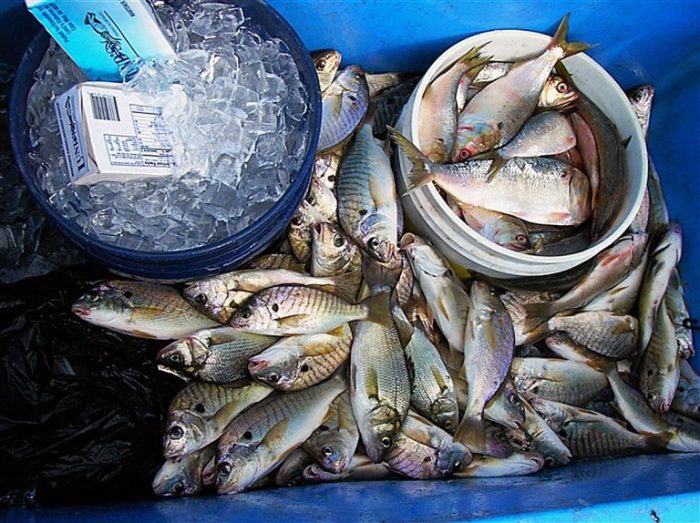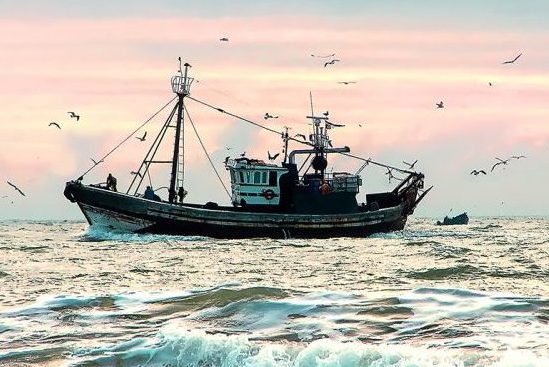Analysis: Why NC imposed new limits on spot, croaker

by
The state Division of Marine Fisheries earlier this spring imposed new recreational bag limits and commercial season closures to protect stocks of spot and Atlantic croaker.
As previously reported, effective April 15, the recreational bag limit for spot and Atlantic croaker is 50 fish per person, per day, per species, and applies to all recreational fishing with hook and line and other gear. In addition, commercial spot and Atlantic croaker seasons will close in December. The commercial fishery for spot will close from Dec. 10 through April 4, and the commercial Atlantic croaker season will close Dec. 16-31.
The management measures announced March 30 are to remain in effect for at least two years for spot and at least three years for Atlantic croaker.
A recreational fishing advocacy group immediately criticized the proclamation, saying the division failed to address the impact of commercial shrimp trawling on the two species. Commercial fishing advocates, however, point to more severely declining stocks in states where trawling is not allowed. And state fisheries biologists say that Atlantic croaker and spot remain among the most abundant fish in North Carolina estuaries.
‘Moderate level of concern’
Fisheries biologist Chris Batsavage, special assistant to councils with the state Division of Marine Fisheries, told Coastal Review the new spot and croaker regulations were prompted by the latest stock analysis that indicated a “moderate level of concern” for the two species.
He said the regulations were required to comply with the Atlantic States Marine Fisheries Commission spot and Atlantic croaker fishery management plans.
“The stock status of both species is monitored by an adaptive management system, which uses stock indicators to track relative abundance compared to a set of reference years,” Batsavage told Coastal Review. “This requires the 50-fish bag limit for the recreational fishery and a 1% reduction in commercial landings from the 10-year average for each state from New Jersey to Florida that has substantial spot and Atlantic croaker landings and does not already have regulations in place, not just North Carolina.”
The Coastal Conservation Association of North Carolina, which represents recreational fishing interests, contends that the bycatch of spot and Atlantic croaker by shrimp trawlers must be reduced to be able to recover to self-sustaining numbers.
“We are certainly willing to do our part to reverse the declines in these important species,” said David Sneed, executive director of Coastal Conservation Association. However, he said, stocks will never recover unless the state acts to reduce bycatch in coastal waters.
A group representing commercial fishing interests says data shows that trawling isn’t the problem, as reflected in recent surveys showing increased abundance of juvenile spot and croaker in Pamlico Sound. The recent management measures provide a cushion while spot and croaker stocks recover, said Glenn Skinner, executive director of the North Carolina Fisheries Association.
“There is concern with the coastwide stocks of spot and croaker, not just in North Carolina. It is widely known that the concern is greater for the states north of North Carolina, where shrimp trawling does not occur, and the stocks appear to be stronger from North Carolina-south where shrimp trawling does occur,” Skinner said.
Skinner said numerous issues, other than commercial and recreational fishing, impact the abundance of spot and croaker.
“Predation and other environmental issues are likely to blame for concerns within the spot and croaker fisheries, as the declines are coastwide and not isolated to North Carolina,” Skinner said.
Morgan Paris, North Carolina Division of Marine Fisheries spot and Atlantic croaker biologist, explained that spot can be found in estuaries and coastal waters from the Gulf of Maine to the Bay of Campeche, Mexico.
“On the Atlantic coast, spot are most abundant from Chesapeake Bay to South Carolina. The management unit is Delaware through the east coast of Florida,” she said. “They are usually found in greater abundance from Delaware Bay south to Georgia during summer and fall months. Spot like to hang out in sandy or muddy shallow estuarine waters during the summer, then move offshore to the continental shelf edge to over-winter.”
Paris said that Atlantic croaker are usually found living in both muddy and sandy bottom habitats from the Gulf of Maine to Argentina and are most abundant from the Chesapeake Bay to Northern Florida.
“The management unit is defined as New Jersey through the east coast of Florida. In North Carolina, they are found throughout coastal waters of the state,” she said.
Dan Zapf, North Carolina Division of Marine Fisheries biologist supervisor, said that while studies have shown reason for concern and commercial and recreational landings for both species have declined, fishery surveys, particularly in the southeastern part of the state, show stable or increasing abundance.
“NCDMF fishery surveys show juvenile Atlantic croaker and spot remain some of the most abundant species in North Carolina estuaries and neither species is at risk of going away,” Zapf said.
Despite this, recreational and commercial spot and croaker landings have decreased throughout their entire ranges during the past two decades, not just in North Carolina, Batsavage said.
Fisheries officials estimate the total Atlantic croaker harvest from New Jersey through the east coast of Florida in 2019 at 4 million pounds. This represents a 91% decline in total harvest since the peak of 47.4 million pounds in 2003, a 92% commercial decline, and 90% recreational decline, he said.
Commercial and recreational fisheries harvested 53% and 46% of the 2019 total, respectively. North Carolina’s Atlantic croaker landings in 2019 were 224,337 pounds from the recreational fishery and 1.28 million pounds from the commercial fishery, according to figures from the Atlantic States Marine Fisheries Commission.
“Total landings of spot in 2019 are estimated at 6.4 million pounds, an increase from 2018 with 4.2 million pounds, and the third lowest total harvest on record. North Carolina spot landings in 2019 were 851,998 pounds from the recreational fishery and 392,067 pounds from the commercial fishery,” said Paris.
The requirements in the Atlantic States Marine Fisheries Commission fishery management plans for spot and Atlantic Croaker are the same for both species.
“The management strategy in the (commission’s) spot and Atlantic croaker fishery management plans is to establish base management measures with the goal of reducing fishing impacts to not worsen periods of low abundance,” Paris said.
For recreational management, if 30% of the fish stock catch estimate is met or exceeded, any state with more than 1% of the total catch is required to institute a bag limit of no more than 50 spot per person, per day.
If 60% stock estimate catch is met or exceeded, all states, including those with more than 1% of the total catch, are required to institute a bag limit of no more than 40 spot per person, per day.
For commercial management, if 30% of the fish stock catch estimate is met or exceeded, any state with more than 1% of the total coastwide catch of each species that does not already have a minimum size limit or possession limit is required to put one in place.
This should include the length of the fishing season, trip limit, and/or size limits to reduce commercial harvest by 1% of the average state commercial harvest from the last 10 years.
States may put in place different rules and regulations for gear and fished area if the rules can be substantiated to achieve the required 1% reduction for the entire state commercial harvest.
Batsavage said the reasons for the lower abundance of adult spot and croaker are unknown.
Studies for both species are conducted at a regional level — New Jersey to Virginia and North Carolina to Florida. Based on the available fishery-independent survey data, both species are single populations through their ranges, he said.
The adult abundance and landings data for spot and croaker have shown lower abundance in the New Jersey-Virginia region than in the North Carolina-Florida region.
“The New Jersey-Virginia region doesn’t have a shrimp trawl fishery, besides a very small-scale fishery that’s being developed in southeast Virginia, which suggests that factors besides shrimp trawl bycatch discards, including natural mortality, movement of each species along the coast, environmental factors, and climate change, are also impacting the stocks,” Batsavage said.
Measures to reduce bycatch
Bert Owens, the Coastal Conservation Association’s state chairman, said the problem is not overfishing, “but aggressive shrimp trawling in North Carolina waters” where both spot and croaker share the same habitat as the shrimp sought by commercial shrimpers.
Reducing spot and croaker catch limits without addressing the shrimp industry’s bycatch of these fish does no good, he said.
Zapf, with the Division of Marine Fisheries, said that the division acknowledges that shrimp trawl bycatch is a concern, which is why previous management actions in the North Carolina Shrimp Fishery Management Plan have addressed discards through area closures to shrimp trawls, net size restrictions and by requiring additional bycatch-reduction devices for shrimp trawls.
Additional measures have been proposed to further reduce bycatch and minimize effects on the ecosystem, including closing more inside waters to shrimp trawling. In August, the Marine Fisheries Commission is expected to select its preferred new management measures for departmental and legislative review.
The division held advisory committee workshop meetings over several days in March to review a draft of changes to the Shrimp Fishery Management Plan known as Amendment 2. A revised version of the draft informed by discussions during the workshops was presented to the Marine Fisheries Commission in May.
The division is accepting public comment until the end of June on proposed management changes.
Currently, nearly half, or 996,690 acres, of North Carolinas estuarine waters are permanently closed to shrimp trawling, and another 76,160 acres are managed with seasonal closures.
Chris Stewart, state Division of Marine Fisheries shrimp biologist, noted that shrimp trawling is prohibited in all designated primary nursery areas and permanent secondary nursey areas in North Carolina.
“While juvenile fish are found throughout the Pamlico Sound, their presence alone does not make an area a nursery area. Nursery area designations are based on the analysis of abundance winter spawned species, size composition, species diversity, and abiotic conditions – bottom type, sediment size, salinity and temperature,” Stewart said. “Additionally, other factors such as growth, predator protection, and movement out of the nursery into the adult habitats are considered in nursery area designated process.”
In addition to closures, since 2019, the Marine Fisheries Commission has required all shrimp trawlers operating in Pamlico Sound to use a combination of bycatch-reduction devices, which Skinner said are tested and proven to reduce the bycatch of finfish by nearly twice the federal requirements. North Carolina now has the most restrictive bycatch-reduction requirements of any coastal state, he said.
Shrimp trawl discard estimates for spot and Atlantic croaker have fluctuated over time with the highest estimates occurring in the late 1980s and early 1990s. However, the number of shrimp trawl trips in North Carolina has been generally declining since at least the mid-1990s, according to the division.














